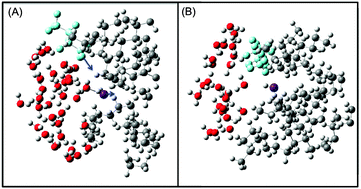Intermolecular network analysis of the liquid and vapor interfaces of pentane and water: microsolvation does not trend with interfacial properties†
Abstract
Liquid:vapor and liquid:liquid interfaces exhibit complex organizational structure and dynamics at the molecular level. In the case of water and organic solvents, the hydrophobicity of the organic, its conformational flexibility, and compressibility, all influence interfacial properties. This work compares the interfacial tension, width, molecular conformations and orientations at the vapor and aqueous liquid interfaces of two solvents, n-pentane and neopentane, whose varying molecular shapes can lead to significantly different interfacial behavior. Particular emphasis has been dedicated toward understanding how the hydrogen bond network of water responds to the pentane relative to the vapor interface and the sensitivity of the network to the individual pentane isomer and system temperature. Interfacial microsolvation of the immiscible solvents has been examined using graph theoretical methods that quantify the structure and dynamics of microsolvated species (both H2O in C5H12 and C5H12 in H2O). At room temperature, interfacial water at the pentane phase boundary is found to have markedly different organization and dynamics than at the vapor interface (as indicated by the hydrogen bond distributions and hydrogen bond persistence in solution). While the mesoscale interfacial properties (e.g. interfacial tension) are sensitive to the specific pentane isomer, the distribution and persistence of microsolvated species at the interface is nearly identical for both systems, irrespective of temperature (between 273 K and 298 K). This has important implications for understanding how properties defined by the interfacial organization are related to the underlying solvation reactions that drive formation of the phase boundary.


 Please wait while we load your content...
Please wait while we load your content...